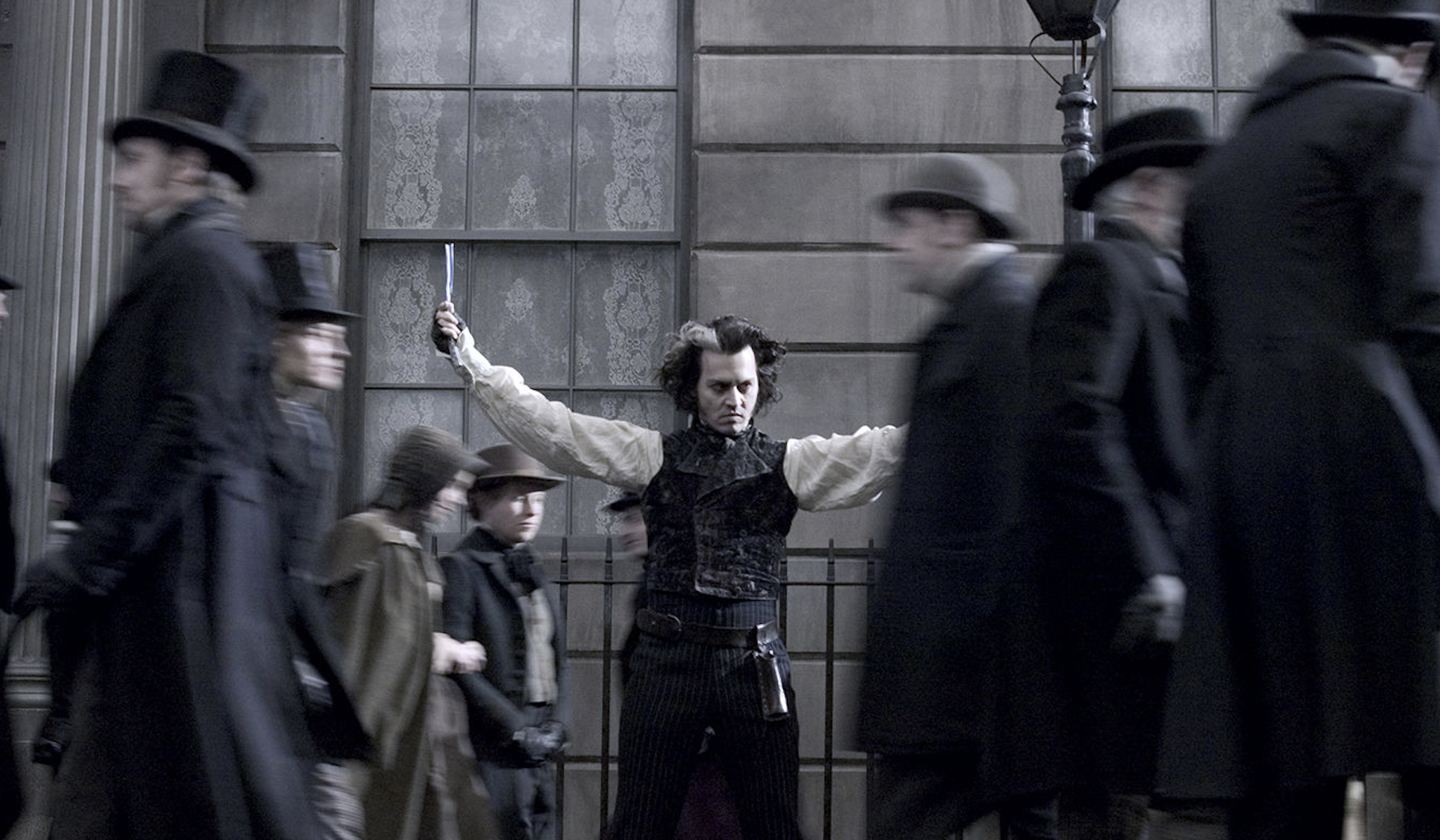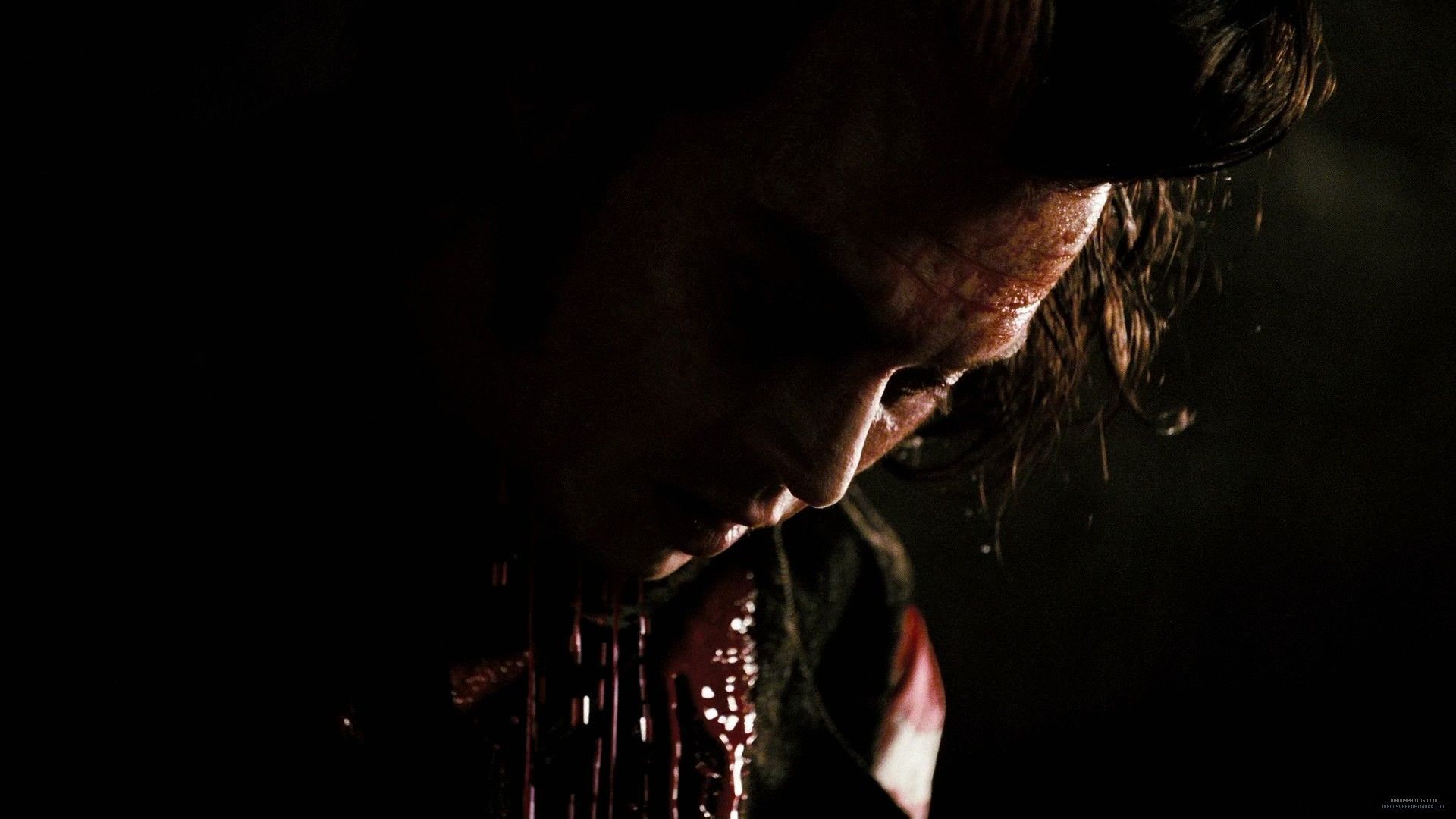Fifteen Years Later, Sweeney Todd’s Macabre Whimsy Holds Up
Review of Sweeney Todd: The Demon Barber of Fleet Street (2007) directed by Tim Burton
Written by Teen Editor Valentine Wulf and edited by TeenTix Teaching Artist Jas Keimig

Cannibalism, capitalism, and class struggle come together in Stephen Sondheim’s darkly humorous satire, Sweeney Todd: The Demon Barber of Fleet Street, beautifully adapted by director Tim Burton for the screen. Songs are cut down and some slashed altogether, shaving an hour off of the stage show’s runtime. The pacing keeps things engaging, and, unless you’re a diehard fan of the original Broadway production, it’s hard to tell anything’s missing. The film manages to do what many other stage-to-screen adaptations miss the mark on—making a movie that stands on its own.
After spending fifteen years in prison for a crime he didn’t commit, mild-mannered barber Benjamin Barker (Johnny Depp) returns home with a thousand-yard stare, a newfound cynicism, and a new name—Sweeney Todd. His last shred of hope is shattered when he discovers his wife Lucy (Laura Michelle Kelly) is dead and his teenage daughter Johanna (Jayne Wisener) is in the custody of the corrupt Judge Turpin (Alan Rickman) who had him sent away. Promising revenge on the aristocrats that ruined their lives, Sweeney and down-on-her-luck baker Mrs. Lovett (Helena Bonham Carter) hatch a delectable plan. But as they build a business off consuming the rich, they too are consumed—Sweeney by violence and Mrs. Lovett by greed—becoming the very things they swore to destroy. After all, you are what you eat.

The film isn’t perfect. The actors—almost entirely non-singers—hit the notes, but don’t have the operatic voices to match the score. Some lines intended to be funny are played so earnestly that the jokes fall flat, and other comedic bits are cut out altogether. A little flimsy and half-baked, you could argue that Sweeney Todd is all style, no substance—but I would argue that it does have substance, and that production designer Dante Ferretti’s showstopping style is what gives it that substance.
Oversaturated colors, dramatic lighting, and bizarre imagined numbers (“By the Sea”, “Epiphany”, “Poor Thing”) give Sweeney Todd a self-aware, period-piece-made-in-the-’60s fever dream kitsch, reminiscent of Mary Poppins and Chitty Chitty Bang Bang. Sweeping wide-shots showcase Ferretti’s immersive sets and create the feel of a stage, while the occasional jarring closeup creates an intimate, claustrophobic tension that would be impossible to achieve in a theater. Sweeney Todd takes full advantage of its status as a film, finding ways to take the stage production’s fourth wall breaks and audience interaction and adapt them into the new medium.
The costumes, by Oscar-winning designer Colleen Atwood, are a beautiful combination of new creations (Sweeney’s leather jacket was custom made with a slight iridescent sheen, “like an insect shell,” Atwood noted in a USA Today interview), and vintage fabrics (one of Mrs. Lovett’s costume pieces was almost 150 years old). While the stage version was set vaguely in the 1840s, the movie seems to be set much later, though Atwood said the designers “took a lot of liberties.” Though the year is never mentioned, details—the dresses’ silhouettes, the fact that the Tower Bridge (completed in 1894) is shown in the opening number, and the distinctly Edwardian beach huts and swimsuits in the number “By the Sea”—suggest a time period between 1894 and 1905, the height of the second industrial revolution. This was the era of transportation, mass production, and incredible wealth disparity.

Sweeney and Mrs. Lovett don’t want to live like the tycoons, politicians, and judges that reign over them. All they want is pastel, white-collar stability. The film beautifully utilizes color to make this point. Sweeney’s flashbacks and Mrs. Lovett’s daydreams are not filled with garish excess. In “By the Sea”, all Mrs. Lovett daydreams of is leisure. She wants to move to the seaside with Sweeney, host guests in a frilly kitchen, go for strolls, and drink tea on the porch. Their memories and imagined futures are full of pastel whimsy, while their reality is the same drab sepia of the faded Daguerreotypes that decorate Sweeney’s barbershop.
Sweeney picks up one of these framed family photos, staining it with stylized Technicolor blood. The garish torrents of Maraschino-cherry red are the only colorful thing in the film besides the flashbacks and daydreams. “Life is for the alive, my dear,” Mrs. Lovett says, as Sweeney obsessively reminisces about the life he once had. But neither of them are truly alive—as the colors illustrate, these are the only things that are real to them. For Sweeney, the past. For Mrs. Lovett, her idealized view of a middle-class future. And for both of them, bloodshed.
In the end, Sweeney doesn’t get his way. In fact, most of his victims end up being nobodies like himself, who he methodically slaughters in a beautifully shot number. We don’t see the same impassioned waltzing, knife-wielding twirls, and violent outrage that Sweeney possessed in the songs “A Little Priest” and “Epiphany”. His revolutionary spirit has died down, and he is visibly becoming more and more detached. And when he finally gets the revenge he’s been after for fifteen years, his killing spree doesn’t stop. He almost accidentally kills his daughter, then finds out Mrs. Lovett is semi-responsible for his wife’s death, and pushes her into the oven in a rage.
Sweeney’s own death is the most anticlimactic in the film. There’s no final battle, no violent struggle. We get the same shot we got as he sang “the work waits; I’m alive at last” in “Epiphany”: Sweeney kneeling as the camera pulls back into a wide shot that makes him look insignificantly tiny amidst the endless brick and metal surrounding him. The first time, he’s shouting his musical manifesto to the sky, but in the second, he’s silently bleeding out in front of an industrial oven.
As Jean-Jaques Rousseau famously said: “When the people have nothing left to eat, they will eat the rich.” That was Sweeney’s argument too, describing industrial London as “a hole in the world” with “a privileged few” sitting at the top. In “A Little Priest'' he and Mrs. Lovett sing, “how gratifying for once to know that those above will serve those down below.” But Sweeney doesn’t overthrow the aristocracy. Once he manages to get his long-awaited revenge, having torn apart his family and left a wake of pointless death, he dies alone in a basement surrounded by his other victims. This isn’t a tale of those above serving those down below, it’s a tale of the rich gazing down into the hole in the world, and watching the poor eat each other.
Lead Photo: Film Still from Sweeney Todd: The Demon Barber of Fleet Street (2007) directed by Tim Burton.
This review was written as part of mentorship program where members of the Teen Editorial Staff receive one-on-one mentorship by Press Corps Teaching Artists and professional critics. The Teen Editorial Staff is made up of 6 teens who lead the TeenTix Newsroom and curate the review portion of the TeenTix blog. More information about the Teen Editorial Staff can be found HERE.
The TeenTix Press Corps promotes critical thinking, communication, and information literacy through criticism and journalism practice for teens. For more information about the Press Corps program see HERE.

